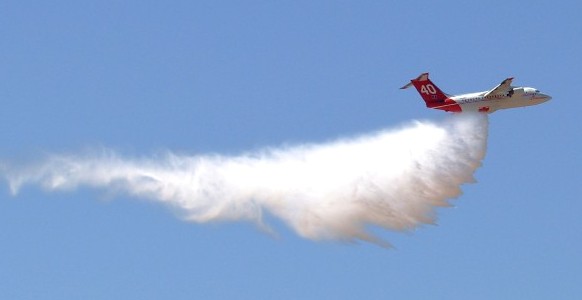Having become interested in the drop patterns of firefighting aircraft, we contacted the United States’ Interagency Air Tanker Board (IATB) that evaluates the performance of air tankers and requested the results of the tests that were conducted for them by the U. S. Forest Service’s San Dimas Technology Development Center. The chart below compares the drop pattern characteristics of seven different air tankers and one drop from a helicopter’s Bambi Bucket. The darkest color represents the heaviest coverage, at 8 gallons per 100 square feet. Lighter colors have less retardant coverage. Click on the image to see a larger version.

I found the differences between the drop patterns of the DC-10, 747, and the MAFFS II to be interesting. The 747 was pretty uniform while the DC-10’s pattern had more variability. The MAFFS II, the latest version of the slip-in system for the military-operated C-130 aircraft, had a much more narrow pattern and more areas of lighter coverage. But the C-130 dropped about 3,000 gallons while the DC-10 and 747 each dropped about 12,000 gallons in the tests.
One of the factors affecting the uniformity of the patterns is the design of the tank system on the aircraft. Both the MAFFS II and the 747 have tanks that are pressurized by compressed air. The pressure forces the retardant out of the tanks through nozzles at a constant flow, while the DC-10 has three tanks attached to the bottom of the aircraft that are modified versions of the tanks produced by Erickson for their Air Crane helicopters. Doors open on the bottom of the DC-10 tanks and gravity pulls the retardant out.
The BAe-146 jet-powered air tanker being developed by Neptune Aviation in Missoula, Tanker 40, appears to have a pressurized constant flow system. Neptune conducted some drop tests of the aircraft in Missoula this summer. Wildfire Today has learned that the aircraft was not able to obtain adequate line lengths for the higher coverage levels. The company has gone back to the drawing board in order to modify the system to increase the flow rates in order to meet the standards.

Minden Air Corp. at Minden, Nevada is also converting a BAe-146 into an air tanker, Tanker 46, but they have not scheduled drop pattern grid testing for the aircraft.
Grid testing involves setting up 800 to 3,000 cups on the ground. After the air tanker or helicopter drops over the cups, the amount of retardant or water in each cup is measured. The cups in the photo below, which were set up for a test, were overrun by cattle. It took several days to straighten the stakes and replace the cup holders.
We were cautioned by the IATB, regarding the tests, that:
- A direct comparison is not always intuitive from these recorded patterns. Close study is required to understand continuity and density for the pattern and determine if the pattern meets the established standards.
- The patterns displayed from the grid testing provide a comparison to the standard set by the Interagency Airtanker Board but do not always translate directly to how the system performs in the field. How the fluid exits the aircraft (under pressure, by gravity, in a block or in a column) can be a significant reason for differences in performance of tanking systems.Terrain, cross wind, gusts, drop height, speed of the aircraft and other conditions may also affect the retardant as it travels to the ground and into the vegetation.


great post thanks
Johnny,
Do you have a link to where it shows that over 3 million gallons of retardant were delivered on fires by the DC10s over the last three years? (That’s over 254 sorties assuming max load)
Thanks.
The “carding” of very large air tankers (VLAT) or any other tankers by the Federal Goverment is not easily accomplished. When a person (country) criticizes a program, it implies those responsible for evaluation are not competent in their decision making. The hard working employees of the VLAT program Federal,State and private sector represent the best aerial fire fighters in the world. These are the professionals that the VLAT companies had to “accomplish the requirements” in order to be carded. This team of experts are critical, analytical and somewhat traditional. This is only the start, non fire personnel(i.e.accountants) have to show that the VLAT is justifiable. The incident commander and staff are held accountable for all operations on a fire. This team represents another critical component of the VLAT program. Like the introduction of heli-tankers twenty years ago, the VLAT are going through the same gauntlet. A most recent report indicates that the DC-10 reduction in cost per gallons delivered is significant when compared to other fixed-wing aircraft traveling the same distance. During the past three fire seasons the DC-10 has delivered on fires 3,054,992 U.S. gallons of retardant on fires.
Where is the test pattern of the most often used airtanker in the fleet, the Marsh S-2T?
Cal Fire has not submitted the their S-2T for evaluation.
We tested the S-2T in 2003 and again in 2005. We have over 150 patterns from the S-2T. Cal Fire does not usually use aircrat that have not been tested.
The graph above was created for a talk I gave about 4 years ago to a group of people who were interested in those particular aircraft. We have many patterns on many systems and I can’t fit them all into 1 talk So, when I make a powerpoint presentation, I try pick patterns that best pertain to the audience.
When I give my talk I let the group know that there are patterns from other systems tested if they want more information.
Hope this helps.